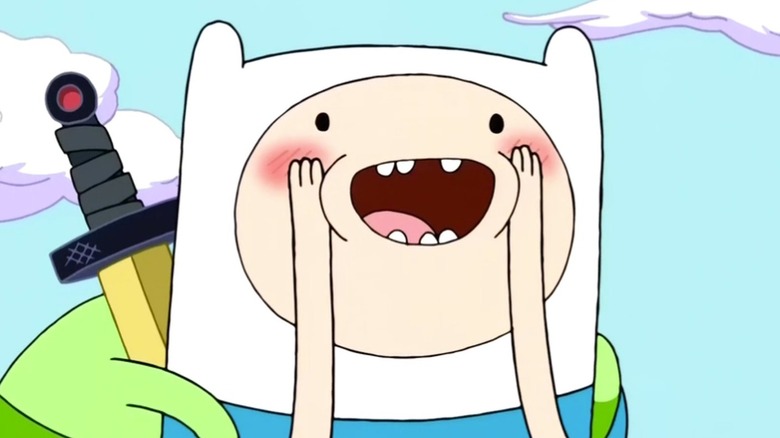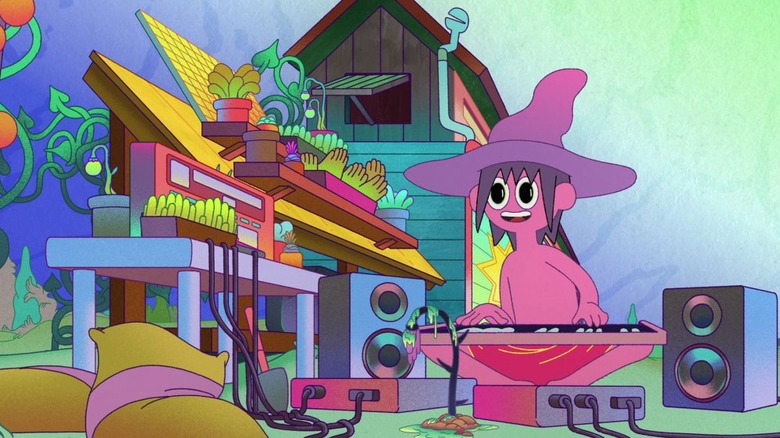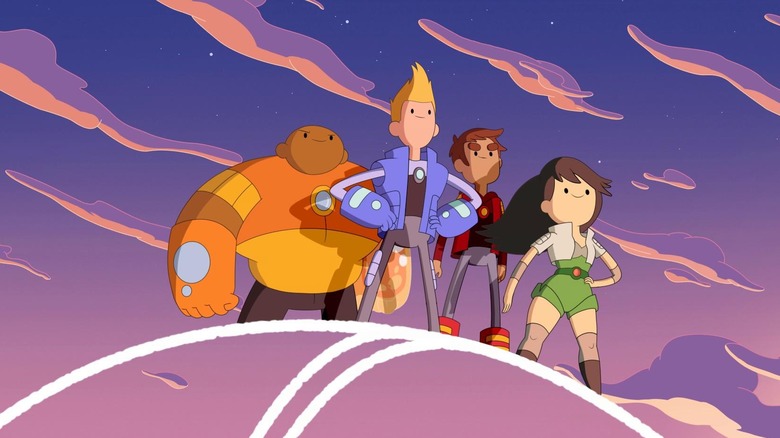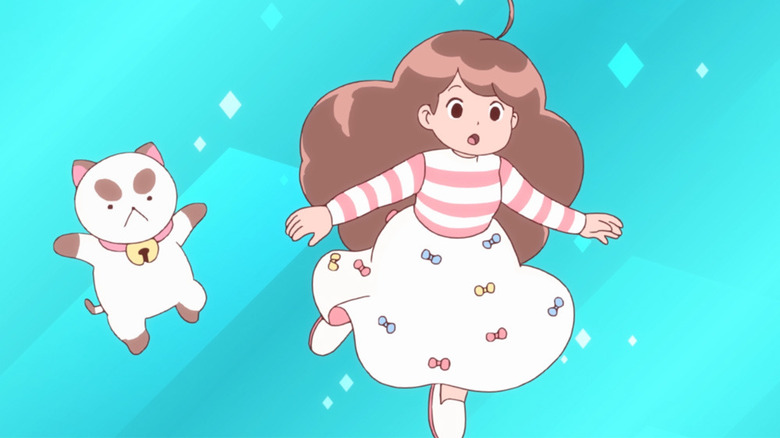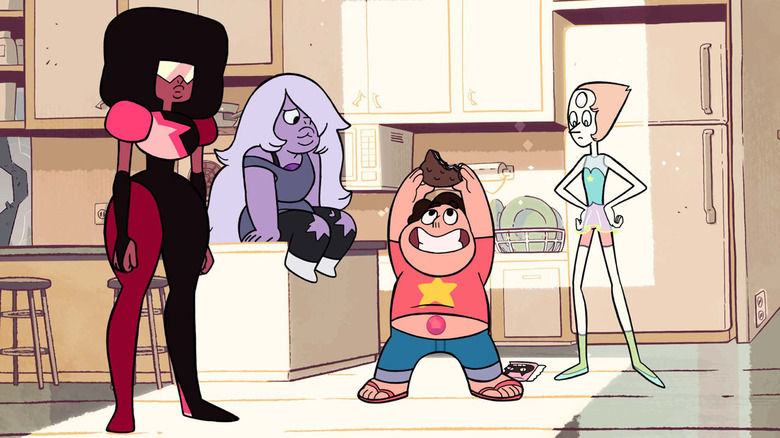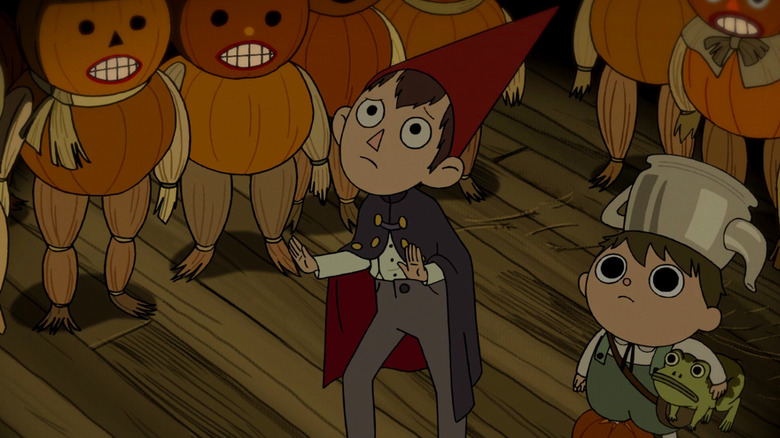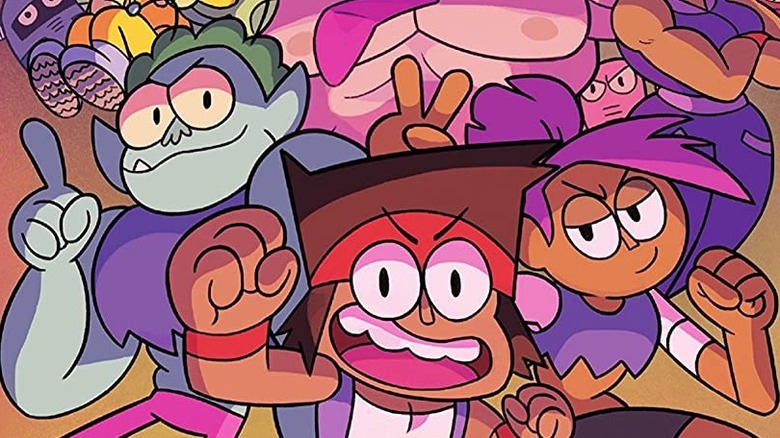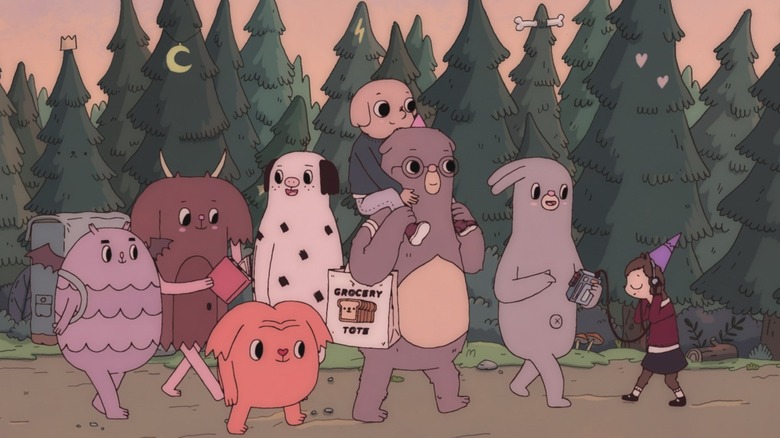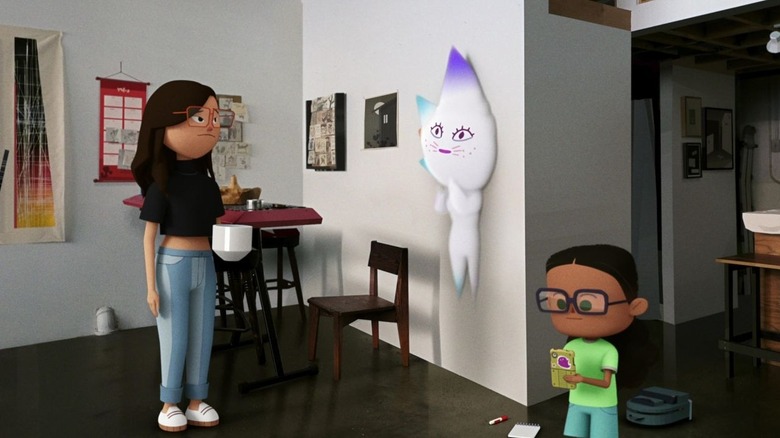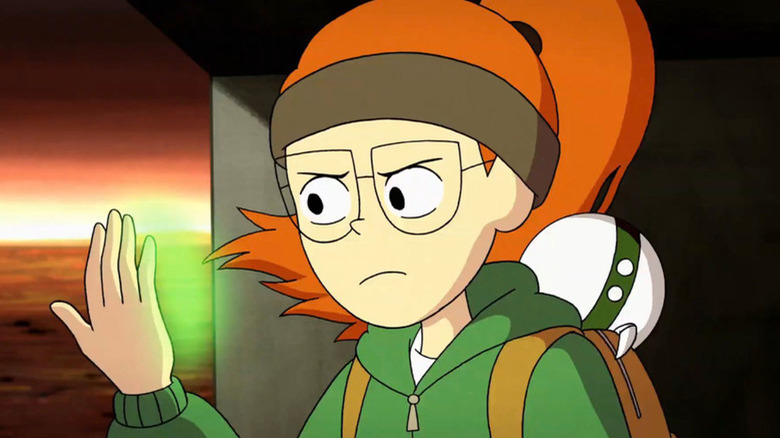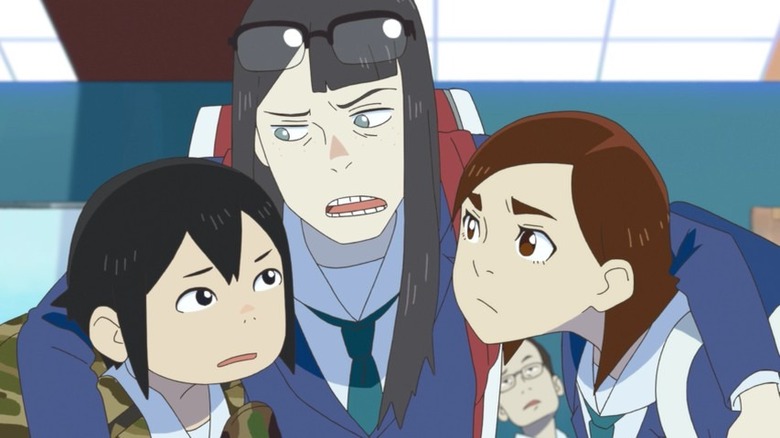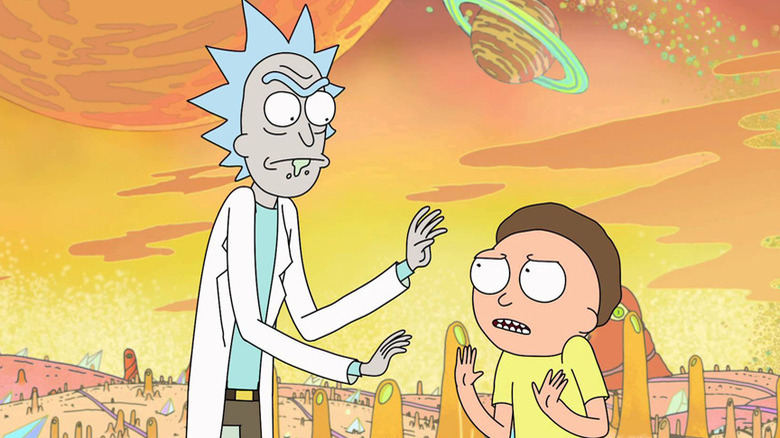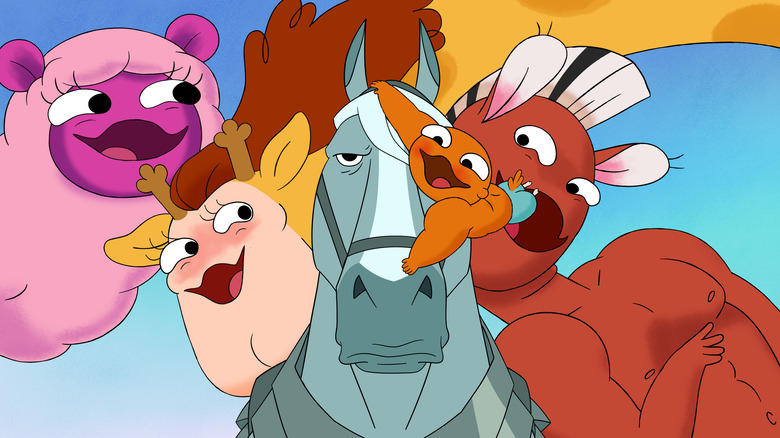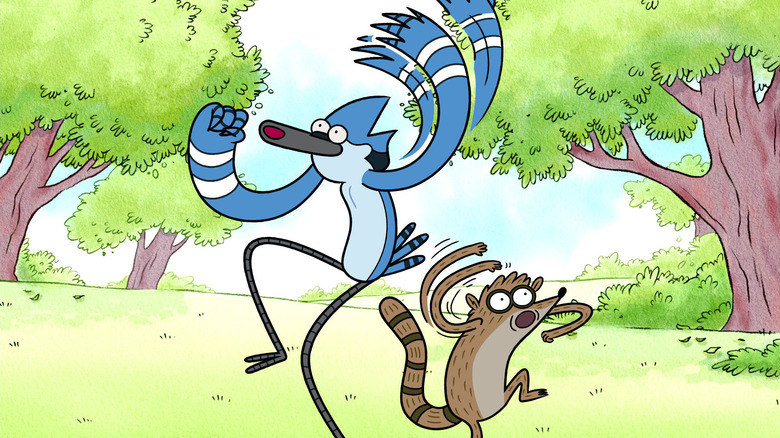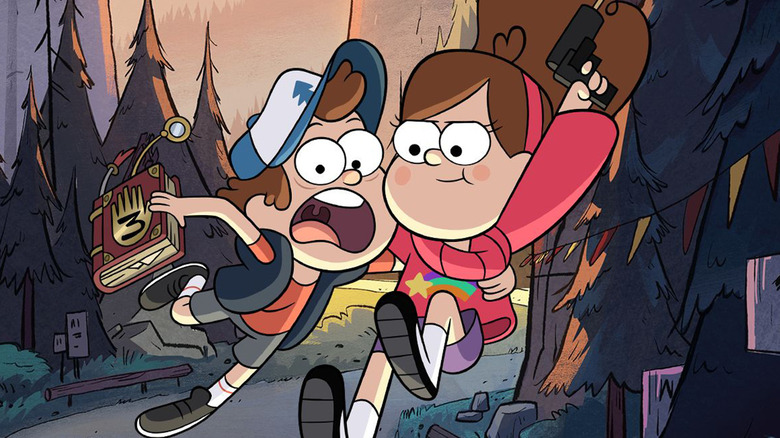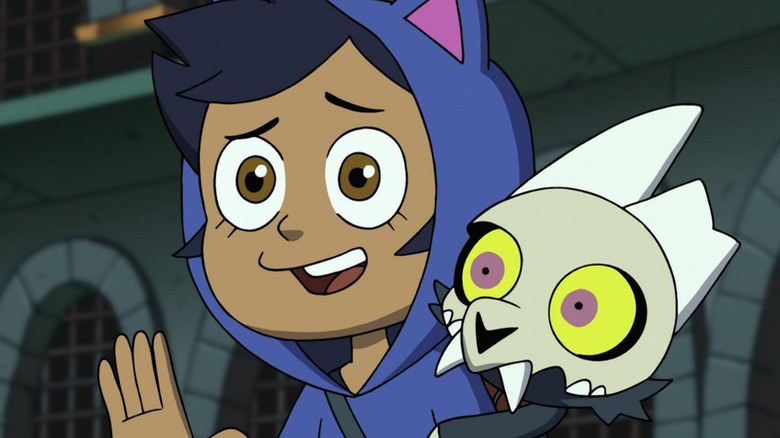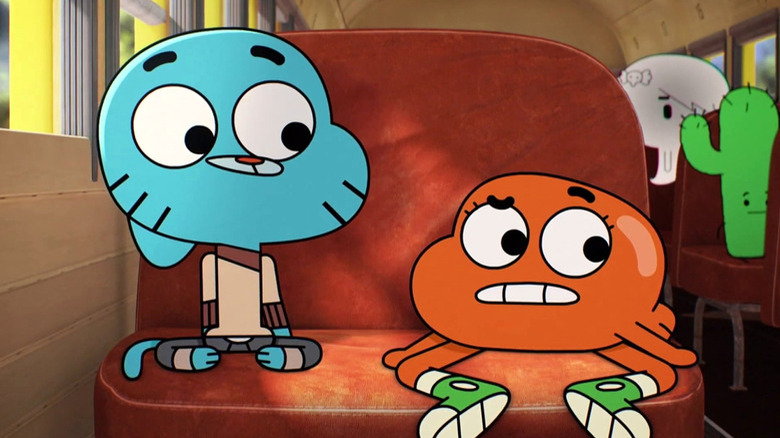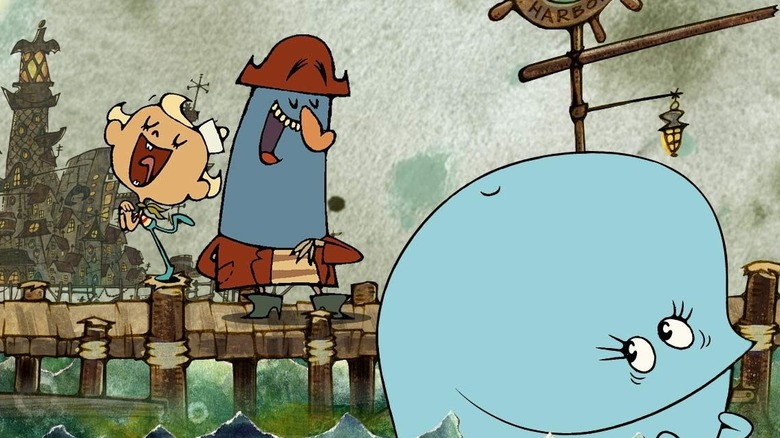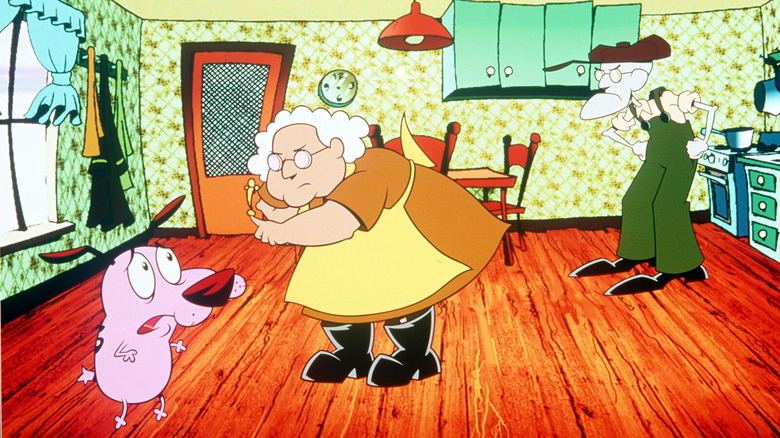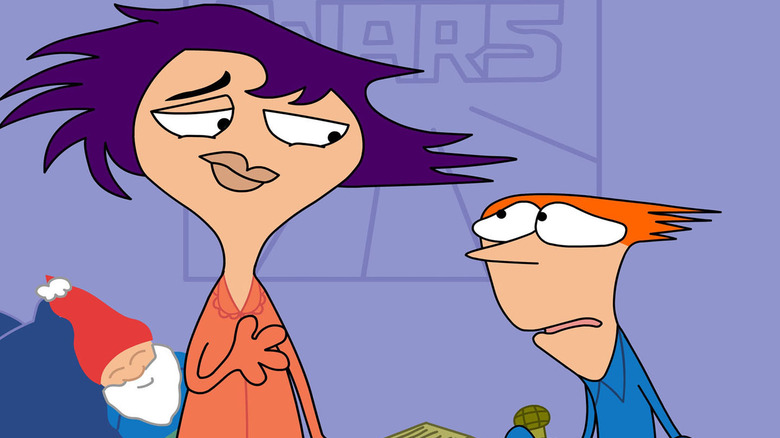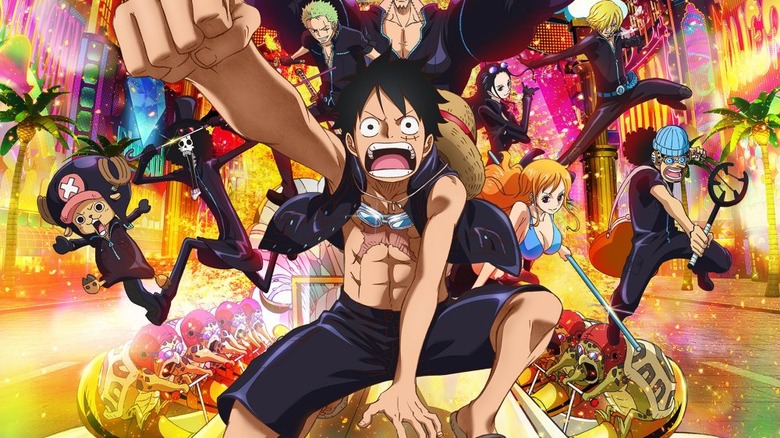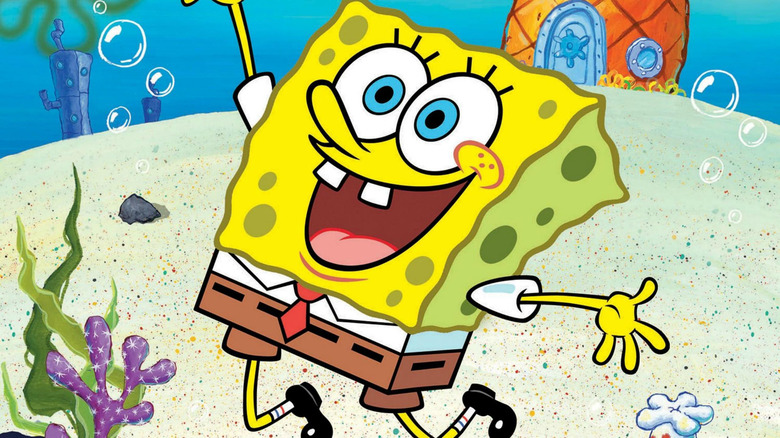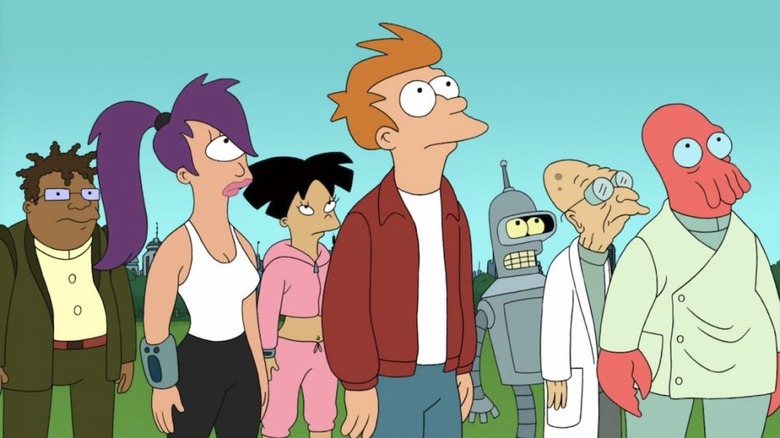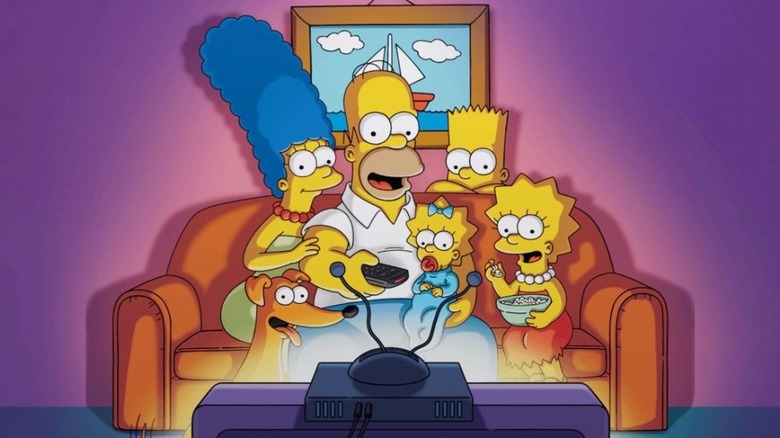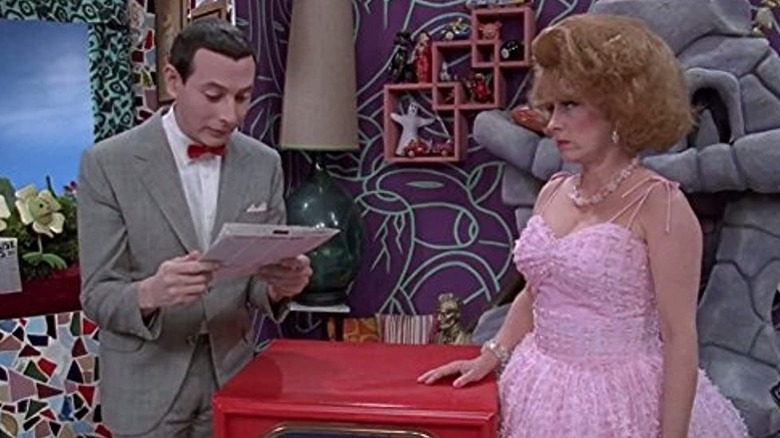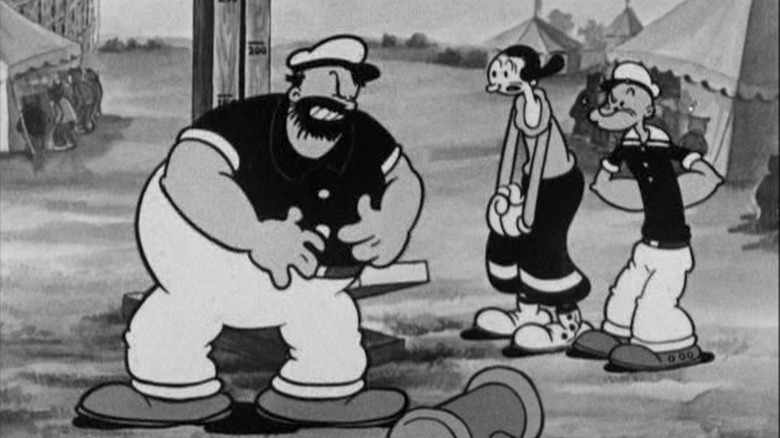25 Shows Like Adventure Time You Should Watch Next
"Adventure Time," Pendleton Ward's fantasy-comedy-adventure series about the teenage human hero Finn and his magical shapeshifting dog brother Jake fighting evil in the post-apocalyptic Land of Ooo, might be the defining animated series of the 2010s. Nickelodeon rejected the initial pilot, allowing Cartoon Network to take the show and turn it into a cultural phenomenon. Premiering in 2010 and running for 283 episodes through 2018, "Adventure Time" initially grabbed audiences via its wild imagination and outrageous sense of humor and kept them invested with its detailed world-building and, at times, profoundly emotional storytelling. It subsequently received four "Distant Lands" specials and a "Fionna and Cake" spinoff series on HBO Max.
Beyond that, the crew of "Adventure Time" have gone on to develop many other successful shows. In addition, many other series have either drawn inspiration from the style of "Adventure Time" or taken advantage of the new ground the series broke for American all-ages animation. For all its innovations, however, "Adventure Time" didn't come from nowhere. It drew inspiration from many series throughout animation and television history. Both the shows "Adventure Time" inspired and those it was inspired by are absolutely worth seeking out for anyone who loves Finn and Jake's totally mathematical adventures. The fun will never end!
The Midnight Gospel
If you're looking for shows similar to "Adventure Time," a good place to start is with other shows created by Pendleton Ward. "The Midnight Gospel," a collaboration between Ward and Duncan Trussell, takes conversations from "The Duncan Trussell Family Hour" podcast and turns them into the lavishly-animated adventures of Clancy, a "simulation farmer" interviewing the denizens of different planets facing their own apocalypses. This eight-episode series, released in 2020, is streaming on Netflix.
Ward's art style and affinity for strange characters and silly gags carry over from "Adventure Time" to "The Midnight Gospel," though, unlike its predecessor, "The Midnight Gospel" is strictly intended for adults. Drugs, death, politics, and spirituality are common topics of discussion, while the animation tells its own surreal stories distinct from the characters' conversations. The final episode, "Mouse of Silver," in which Clancy/Trussell interviews his dying mother, has been widely praised by outlets such as Polygon as the highlight of the series.
Bravest Warriors
"Bravest Warriors" is the other series created by Pendleton Ward. Unlike "Adventure Time" and "The Midnight Gospel" however, Ward was not involved with the production of the series beyond its original 2009 pilot for Nickelodeon. Breehn Burns, Will McRobb, and Chris Viscardi developed the pilot into a streaming series for Frederator's Cartoon Hangover channel on YouTube and VRV. It ran for four seasons from 2012 to 2018, with Canadian studio Nelvana taking over production for the fourth season.
This sci-fi comedy follows four teen heroes (Chris, Beth, Danny, and Wallow) who save alien worlds through the power of their emotions. Slightly edgier than "Adventure Time," the series has a similar combination of random absurdist humor and serialized storytelling. The series' most popular character wasn't any of the Bravest Warriors themselves but rather the supporting character Catbug, an adorable cat-ladybug hybrid voiced by child actor Sam Lavagnino, who Deadline reports has his own spinoff series in development.
Bee and PuppyCat
Natasha Allegri worked as an artist for "Adventure Time," most famously creating the series' gender-swapped "Fionna and Cake" universe. Her 2013 pilot for Cartoon Hangover, "Bee and PuppyCat," became so popular that Frederator raised $872,133 via Kickstarter for a 10-episode series. One of the rare American animated series targeted at young adult women, the cartoon follows the adventures of a cheerful temp worker taking inter-dimensional assignments and a half-dog half-cat creature who speaks via Vocaloid sounds and might be a cursed prince.
"Bee and PuppyCat" draws a lot of inspiration from anime like "Sailor Moon" and "Pokemon" studio OLM did the animation for the final four episodes of Season 1 and all of the second season, titled "Bee and PuppyCat: Lazy in Space." Every episode of "Lazy in Space" was leaked on to Vimeo by producer Fred Siebert in 2020 before officially premiering on Netflix in 2022, according to Polygon.
Steven Universe
Rebecca Sugar was a storyboarder on "Adventure Time" for Seasons 2-5, credited on many of the show's most memorable episodes. They were instrumental in developing the character of Marceline the Vampire Queen, as noted by the Los Angeles Times, helping to establish her tragic past with Simon Petrikov and her relationship with Princess Bubblegum. Sugars' own series, "Steven Universe," ran from 2013-2020 and built upon much of what made their work on "Adventure Time" great.
Like "Adventure Time," "Steven Universe" starts as a lighthearted comedy before going in more serious dramatic directions. Sugar plotted out the arcs and backstories of "Steven Universe" in advance, resulting in a show that rewards repeat viewing with its extensive foreshadowing. The show broke massive ground for LGBTQ+ representation in children's animation with multiple relationships between the female-presenting Crystal Gem aliens. "Steven Universe" wrapped up its initial storyline within five seasons, followed by a TV movie and the epilogue series "Steven Universe Future."
Over the Garden Wall
"Over the Garden Wall" is a 10-episode miniseries created by Patrick McHale, the creative director for the first two seasons of "Adventure Time." The story centers around two brothers, the anxious teenager Wirt and the younger carefree Greg, as they try to find their way home by venturing through the mysterious forest of the Unknown while encountering strange and mysterious characters.
Premiering on Cartoon Network in 2014, "Over the Garden Wall" has become go-to autumnal viewing for many an animation lover. Its unique style is inspired by 1930s cartoons and other artifacts of early 20th century Americana. It's at once cute, creepy, funny, and serious, with a perfect ending to its self-contained tale. Like with "Adventure Time," you can expect many of the songs to stick in your head. McHale went on to co-write the screenplay for Guillermo Del Toro's stop-motion film for adaptation of "Pinocchio" produced for Netflix.
OK K.O.! Let's Be Heroes
Ian Jones-Quartey was a storyboard supervisor and revisionist on "Adventure Time" and an executive producer on "Steven Universe" before creating his own series, "OK K.O.! Let's Be Heroes." Initially a pilot titled "Lakewood Plaza Turbo" in 2013, Cartoon Network experimented with releasing video games and shorts featuring the characters before launching the series proper in 2017. The show was originally intended for a streaming debut, but delays in the launch of HBO Max prevented this from happening and ultimately led to the show's cancelation.
"OK K.O.!" is set in a world where everyone has superpowers, though power levels vary dramatically. The main character, K.O., is an optimistic but not particularly powerful kid who works in a bodega alongside the alien Radicles and the ninja Enid. This is a cartoon that loves being a cartoon, with zany animation and clever meta-comedy. "Adventure Time" fans will especially want to check out the episode "Crossover Nexus," where characters from "Adventure Time" and almost every other Cartoon Network Original make cameos.
Summer Camp Island
Julia Pott, a British animator whom indie animation fans might also recognize as the voice of Emily in the "World of Tomorrow" films, joined "Adventure Time" later in its run. She worked as a writer on the show from the "Elements" miniseries up until the series finale "Come Along With Me." In 2018, the same year "Adventure Time" concluded, her original series "Summer Camp Island" premiered on Cartoon Network. The two-part first season aired on TV over two summers, while subsequent seasons have been HBO Max exclusives.
"Summer Camp Island" takes place in a world of magic and anthropomorphic animals, following best friends Oscar and Hedgehog as they partake in the many strange events their summer camp has to offer. Many other artists and writers from "Adventure Time" have worked on the series, which showcases a similar aesthetic but has a generally more relaxed atmosphere and skews towards a slightly younger demographic.
City of Ghosts
Elizabeth Ito was a storyboard artist for "Adventure Time" Season 1 and returned as a supervising director in Season 5. Her pilot "Welcome to My Life" was unfortunately passed on by Cartoon Network despite its viral popularity, but she got the chance to apply her style of naturalistic dialogue and mixed-media animation to "City of Ghosts," which was released in six episodes on Netflix in 2021.
"City of Ghosts" is about a group of four kids making documentaries about investigating various hauntings around Los Angeles. Each episode explores a different aspect of the city's rich multicultural history, something both kids and adults can learn something from. It's closer to a PBS Kids show than to "Adventure Time," but fans of the latter will appreciate its artistry. Pendleton Ward co-wrote and co-directed Episode 5, "Bob and Nancy." Disappointingly, a second season appears unlikely, as Ito has said the series likely wouldn't have been greenlit at all under Netflix Animation's current management.
Infinity Train
If "Adventure Time" was the start of an era in which Cartoon Network was actively seeking teen and young adult audiences with slightly more mature programming than usual, "Infinity Train" might mark the end of that era. Created by "Regular Show" writer Owen Dennis, this sci-fi anthology series follows different passengers trapped on a train from which they can only escape by facing their deep-seated personal issues. Each car on the endless train has a different theme, with quirky denizens and creative puzzles to solve.
Two seasons, or Books, aired on Cartoon Network in 2018 and 2019, while two more were released as HBO Max exclusives in 2019 and 2020. Dennis had plans for an eight-season arc but explained that his pitch for Book 5 was rejected by the studio due to lacking a "child entry point" in a Reddit AMA. It's a shame "Infinity Train" was canceled so soon, but the four seasons that did get made stand as excellent examples of how animation can address complex themes in a way that's accessible to all audiences.
Keep Your Hands Off Eizouken!
Arguably the best of the various guest-directed episodes of "Adventure Time" was Season 6's "Food Chain," which was helmed by Masaaki Yuasa. One of the most artistically inventive directors in the world of anime, Yuasa has directed series ranging from the sports drama "Ping Pong: The Animation" to the ultraviolent action series "Devilman: Crybaby." Of his television anime, the closest in tone to "Adventure Time" is "Keep Your Hands Off Eizouken!"
A 12-episode adaptation of the manga by Sumito Owara, "Keep Your Hands Off Eizouken!" is about three passionate high school girls setting out to produce their own anime. With a great sense of humor and plentiful flights of fancy into the girls' imaginations, it's a celebration of what the animation medium is capable of. Even if you're not a regular anime watcher, "Eizouken" is so enjoyable that critics from both The New York Times and The New Yorker listed it as one of the best TV shows of 2020.
Rick and Morty
When "Rick and Morty" first premiered on Adult Swim in 2013, co-creator Justin Roiland was most famous for voicing the Earl of Lemongrab on "Adventure Time." The unhinged energy of Roiland's performance as Princess Bubblegum's first experiment gone wrong carries over into the array of characters Roiland voices in his show, including both Rick and Morty.
If "Adventure Time" could sometimes get dark and disturbing within the context of an all-ages show (especially when Lemongrab was involved), the adults-only "Rick and Morty" takes things a hundred times further. The adventures of the alcoholic misanthrope Rick and his increasingly traumatized grandson Morty are far more cynical than anything in Finn and Jake's journeys. Despite their obvious differences, "Rick and Morty" has a similar sense of inventive world-building and unpredictability to "Adventure Time." Dan Harmon and Justin Roiland's series has been renewed for at least ten seasons by Adult Swim.
Centaurworld
The 20-episode 2021 Netflix series "Centaurworld," created by Megan Nicole Dong, plays like an apotheosis of all the major trends in American all-ages animation throughout the preceding decade. Like the Land of Ooo in "Adventure Time," Centaurworld is a colorful land full of wacky characters that hides some incredibly dark secrets underneath its random meme-ready exterior. The main character, Horse, is transported to Centaurworld while fighting a war in her anime-style universe. Much of the conflict and humor of the series stems from Horse not fitting in with her new herd.
"Centaurworld" is also a full-blown musical with multiple songs in every episode, certain to appeal to fans of "Steven Universe," "My Little Pony: Friendship is Magic," and Disney musicals. It might be one of the rare cartoons to exceed "Adventure Time" in sheer trippiness. Strange as it gets, it manages to tell an emotionally powerful story with an immensely satisfying finale.
Regular Show
Premiering only a few months after "Adventure Time" in 2010, "Regular Show" solidified Cartoon Network's direction towards older-skewing programming in the early 2010s. Whereas "Adventure Time" took a relatively traditional coming-of-age set-up for a kids' show and then got weird enough with it that adults paid attention, "Regular Show" was essentially an adult slacker comedy toned down just enough that kids could watch and enjoy it. It's telling J.G. Quintel first created the characters of Mordecai, Pops, and Benson for his decidedly R-rated student film "2 in the AM PM."
Quintel storyboarded one episode of "Adventure Time," the Season 1 entry "Ocean of Fear." "Adventure Time" and "Regular Show" were often scheduled back-to-back. At one point, they shared a programming block called "Regular Time Adventure Show," and BOOM! Studios published a comic book crossover between the series. While their comedic and storytelling sensibilities differed, fans of one show generally had at least some appreciation for the other. "Regular Show" ran for eight seasons, with a total of 261 episodes.
Gravity Falls
While "Adventure Time" and "Regular Show" were reinvigorating Cartoon Network, Disney's coolest cartoon in the mid-2010s was "Gravity Falls," created by Alex Hirsch. Playing like a family-friendly cross between "The Simpsons" and "The X Files," "Gravity Falls" followed twin siblings Dipper and Mabel Pines as they spent one strange summer with their great uncle, or Grunkle, Stan in the mysterious town of Gravity Falls, Oregon. As with many contemporaries of "Adventure Time," it started as an episodic comedy series before gradually building up to a complicated ongoing narrative.
Switching networks from The Disney Channel to Disney XD midway through its run, "Gravity Falls" experienced many lengthy hiatuses; its two seasons took four years to air from 2012-2016. Fortunately, each half-hour gave viewers plenty to talk about and analyze, with tons of hidden jokes and coded clues for those clever enough to seek them out. Hirsch ended the show on his terms, with the epic "Weirdmageddon" three-parter.
The Owl House
Created by "Gravity Falls" storyboard artist Dana Terrace, "The Owl House" continues to provide kids some weirder and darker entertainment amongst the Disney Channel lineup. The series centers on hyperactive misfit teenager Luz, a huge fan of fantasy novels who finds herself transported to the magical realm of the Boiling Isles. She lives with the outlaw witch Eda the Owl Lady along with the adorable demon King while training in the magical arts and finding creative solutions.
Shippers into the relationship between Marceline and Princess Bubblegum in "Adventure Time" should easily become obsessed with Luz's romance with her haughty but misunderstood witch classmate Amity Blight. Luz is the first bisexual protagonist in a Disney animated series. Despite the show's critical acclaim and fan popularity, the third and final season of "The Owl House" was disappointingly cut short to only a few hour-long specials. Terrace claimed on Reddit that this is due to changing management feeling the series didn't suit the Disney Channel's brand.
The Amazing World of Gumball
Another defining Cartoon Network show of the 2010s, "The Amazing World of Gumball" stands out for its multi-layered comedy and bold mixed-media animation style, which combines 2D, 3D, puppets, and live-action elements. The wide cast of characters, led by the troublemaking 12-year-old cat Gumball and his naive 10-year-old pet goldfish-turned-adopted brother Darwin, are all based on various cartoon ideas that series creator Ben Bocquelet had previously pitched and had rejected from other studios.
Running for 252 episodes over six seasons from 2011 to 2019, "The Amazing World of Gumball" has the fourth-highest episode count of any Cartoon Network series, behind only "Teen Titans Go!" "Adventure Time," and "Regular Show." Unlike "Regular Show" and "Adventure Time," which mostly disappeared from the network's schedule after they ended, "The Amazing World of Gumball" is still shown regularly in reruns. A feature film and a spin-off series have both been announced for Cartoon Network and HBO Max.
The Marvelous Misadventures of Flapjack
"Adventure Time" launched the careers of tons of successful cartoon creators, but what show launched Pendleton Ward's career before "Adventure Time" became a series? The answer is "The Marvelous Misadventures of Flapjack," which ran for three seasons on Cartoon Network between 2008 and 2010. The seafaring candy-craving adventures of the eager young sailor Flapjack and his crusty mentor Captain K'nuckles play like a clear predecessor to the adventures of Finn and Jake.
Created by Thurop van Orman, "The Marvelous Misadventures of Flapjack" was responsible for launching even more careers than just Ward's. J.G. Quintel was the creative director of the first two seasons before he started making "Regular Show," and Patrick McHale ("Over the Garden Wall") and Alex Hirsch ("Gravity Falls") also got their start as storyboard artists on the series. It feels safe to say that without "Flapjack," the animation industry today would look very different.
Courage the Cowardly Dog
Which of the Cartoon Network original series made in the decades before "Adventure Time" is the closest match to the sensibility of Pendleton Ward's influential hit? The obvious antecedent of "The Marvelous Misadventures of Flapjack" aside, the closest spiritual predecessor to "Adventure Time" might be "Courage the Cowardly Dog."
"Courage the Cowardly Dog" was created by John R. Dilworth and based on the Oscar-nominated short film "The Chicken From Outer Space." The show is about an easily frightened canine who nonetheless must protect his elderly owners, Muriel and Eustace, from all sorts of otherworldly terrors in the Middle of Nowhere. Compared to the other late '90s Cartoon Network series, "Courage the Cowardly Dog" was significantly scarier than its peers and had more moments of earnest sweetness, which are both qualities that "Adventure Time" would later demonstrate. The show's thin-line art style is also a closer match to "Adventure Time" than to the retro thick-lined design of its Cartoon Network contemporaries.
Home Movies
Out of all the early Adult Swim shows, "Home Movies" might not be the one most people would immediately connect with "Adventure Time." One might more naturally associate the random humor and fast pace of "Adventure Time" with more off-the-wall Adult Swim favorites like "Space Ghost: Coast 2 Coast" or "Aqua Teen Hunger Force." Nonetheless, Pendleton Ward has cited Loren Bouchard and Brendan Small's sitcom, which Adult Swim rescued from its initial cancelation on UPN, as a major influence.
The reason Ward loves "Home Movies," as well as its Squigglevision predecessor "Dr. Katz," is the dialogue. In a 2014 interview with Maria Bustillos, Ward said, "those cartoons are so relaxing to watch. It's nice to watch conversational dialogue that feels natural and it's not over the top and cartoony and shrill, in shrill voices or anything." As out there as "Adventure Time" gets conceptually, it's that down-to-Earth sensibility in its writing that made the show so lovable.
One Piece
While various "Adventure Time" alums have gone on to make such anime-inspired series as "Steven Universe" and "Bee and PuppyCat," "Adventure Time" itself typically didn't draw particularly heavily from Japanese anime for inspiration. Anime, however, is a vast medium, and there are certainly anime out there that should appeal to "Adventure Time" fans. "One Piece," which Rebecca Sugar told TheWrap they were obsessed with growing up, has many the same qualities that make "Adventure Time" great.
"One Piece" is based on Eiichiro Oda's hit manga in Weekly Shonen Jump and has been running for over a thousand episodes since 1999. The series revolves around a crew of pirates, led by the rubber-bodied boy Monkey D. Luffy, as they sail the seven seas in search of the legendary One Piece treasure. Its wacky characters and cartoony designs eschew any sense of realism, but even with all this gleeful silliness, the action gets intense, and the story's personal and political drama is taken seriously. The length of both the manga and anime can be intimidating for newcomers, but even if you can't commit to the full binge, "Adventure Time" fans will still find a lot to like in "One Piece."
SpongeBob SquarePants
Before it began shifting in more dramatic directions starting in its third season, "Adventure Time" was mainly recognized for two things: being really weird and really funny. "Weird and funny" also perfectly describes "SpongeBob SquarePants." Stephen Hillenberg's absurdist comedy about a hyper-optimistic sea sponge fry cook has been entertaining audiences of all ages since 1999 and continues to dominate Nickelodeon's TV schedule.
It's likely many of the younger artists working on "Adventure Time" grew up watching and loving "SpongeBob SquarePants." Many of the older "Adventure Time" crew members worked on "SpongeBob" beforehand. Derek Drymon and Nick Jennings, two of the producers who helped Hillenberg develop the idea for "SpongeBob," were also producers on "Adventure Time," with Jennings also serving as an art director who painted many of the "Adventure Time" title cards.
Larry Leichliter, a director for "SpongeBob" and other Nicktoons, directed a whopping 114 episodes of "Adventure Time," including the entirety of the first four seasons, and stayed attached to the show up until its conclusion. And of course, Tom Kenny, the iconic voice of SpongeBob, would deliver just as memorable a performance as the "Adventure Time" villain-turned-tragic hero Ice King.
Futurama
For many adults watching "Adventure Time" for the first time, one of the most instantly noticeable things about the show is that Jake the Dog sounds a lot like Bender Bending Rodriguez, the lovably immoral robot from Matt Groening's sci-fi cartoon "Futurama." Jake and Bender are both voiced by John DiMaggio, who made both of these very distinct characters his own.
"Adventure Time" had fun with this "Futurama" connection in the Season 6 episode "Everything's Jake," where Billy West played various characters inside Jake's body using the voices of three of his "Futurama" characters: Philip J. Fry, Professor Farnsworth, and Zapp Brannigan. Finn and Jake also cameoed in the "Futurama" Season 7 episode "Leela and the Genestalk." It makes sense both shows' crews shared an appreciation for each other. After all, "Futurama" did a lot of the same things for adult animation as "Adventure Time" did for kids' animation by using a comedic pastiche to build an intricate mythology with characters who can make viewers both laugh and cry within the same episode.
The Simpsons
No American animated comedy over the past 30 years can escape the influence of "The Simpsons." Matt Groening's long-running satirical take on the family sitcom set the bar high for its genre, and Pendleton Ward has called it the show that made "the biggest impression" on him growing up (via AWN). His childhood crush on Lisa Simpson was a motivation for the creation of quirky and lovable female characters in "Adventure Time."
Matt Groening himself crashed the "Adventure Time" panel at San Diego Comic-Con 2011, recounting the story of how he gave a young Ward advice on animation and saying that, "other than my own stuff, ["Adventure Time"] is my favorite!" "The Simpsons" would share the love in the couch gag for the Season 28 episode "Monty Burns' Fleeing Circus," which featured an elaborate parody of the "Adventure Time" theme song sung by Ward himself. Fans of both "The Simpsons" and "Adventure Time" should also read Rebecca Sugar's comic "Don't Cry for Me, I'm Already Dead," a tragedy written entirely in "Simpsons" quotes.
Pee-wee's Playhouse
The idea of entertainment ostensibly for children being written with an adult audience in mind isn't anything new, with examples ranging from the complex math jokes in Lewis Caroll's "Alice" books to the Cold War satire in "Rocky and Bullwinkle." "Pee-wee's Playhouse," however, is by far one of the most influential TV shows in regards to the rise of such "kidult" entertainment from the late '80s onward. Paul Reubens' Pee-wee Herman character was created for the stage as an adult parody of kids' shows but somehow got a Saturday morning program of his own from 1986 to 1990.
In "Pee-wee's Playhouse," absolutely any object could be a sentient character, a predecessor to the whimsical absurdities of such extremes of anthropomorphism like Embryo Princess and Bounce-House Princess in "Adventure Time." Like "Adventure Time," it was able to present good-natured entertainment and positive messages to kids while also offering plenty of innuendo for adult viewers to pick up on. Pendleton Ward cited the dramatic build-up of the "Pee-wee's Playhouse" opening theme as an influence on the "Adventure Time" theme song during an interview with Art of the Title.
Popeye the Sailor
Many people, including the show's producer Fred Seibert in an interview with IndieWire, have compared the round curves and noodle-limbed figures that define "Adventure Time" to the "rubber hose" style of animation popular in the 1920s and '30s. Max and Dave Fleischer were the masters of this simple yet fluid style, creating such characters as Koko the Clown, Bimbo, and Betty Boop as well as adapting E.C. Segar's comic strip character Popeye the Sailor to animation.
Whereas their big competitor Walt Disney leaned towards more family-oriented stories and increasingly realistic artwork, the Fleischers' shorts dive into full-on surrealism with a sense of humor aimed more at adults. The cartoons made before the stricter enforcement of the Motion Picture Production Code in 1934 are particularly striking in their edgier content. These shorts are still funny to this day, providing direct inspiration to the likes of "Over the Garden Wall" and the video game "Cuphead."
